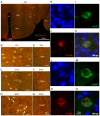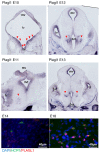Involvement of PLAGL1/ZAC1 in hypocretin/orexin transcription
- PMID: 30896835
- PMCID: PMC6445593
- DOI: 10.3892/ijmm.2019.4143
Involvement of PLAGL1/ZAC1 in hypocretin/orexin transcription
Abstract
The hypocretin/orexin neuropeptide system coordinates the regulation of various physiological processes. Our previous study reported that a reduction in the expression of pleomorphic adenoma gene‑like 1 (Plagl1), which encodes a C2H2 zinc‑finger transcription factor, occurs in hypocretin neuron‑ablated transgenic mice, suggesting that PLAGL1 is co‑expressed in hypocretin neurons and regulates hypocretin transcription. The present study examined whether canonical prepro‑hypocretin transcription is functionally modulated by PLAGL1. Double immunostaining indicated that the majority of hypocretin neurons were positive for PLAGL1 immunoreactivity in the nucleus. Notably, PLAGL1 immunoreactivity in hypocretin neurons was altered in response to several conditions affecting hypocretin function. An uneven localization of PLAGL1 was detected in the nuclei of hypocretin neurons following sleep deprivation. Chromatin immunoprecipitation revealed that endogenous PLAGL1 may bind to a putative PLAGL1‑binding site in the proximal region of the hypocretin gene, in the murine hypothalamus. In addition, electroporation of the PLAGL1 expression vector into the fetal hypothalamus promoted hypothalamic hypocretin transcription. These results suggested that PLAGL1 may regulate hypothalamic hypocretin transcription.
Figures






Similar articles
-
Transcriptional regulation of the hypocretin/orexin gene by NR6A1.Biochem Biophys Res Commun. 2010 Dec 10;403(2):178-83. doi: 10.1016/j.bbrc.2010.11.001. Epub 2010 Nov 5. Biochem Biophys Res Commun. 2010. PMID: 21056546 Free PMC article.
-
Identification of Plagl1/Zac1 binding sites and target genes establishes its role in the regulation of extracellular matrix genes and the imprinted gene network.Nucleic Acids Res. 2017 Oct 13;45(18):10466-10480. doi: 10.1093/nar/gkx672. Nucleic Acids Res. 2017. PMID: 28985358 Free PMC article.
-
Hypocretin/orexin loss changes the hypothalamic immune response.Brain Behav Immun. 2016 Oct;57:58-67. doi: 10.1016/j.bbi.2016.06.009. Epub 2016 Jun 16. Brain Behav Immun. 2016. PMID: 27318095
-
Transcriptional regulation of the hypocretin/orexin gene.Vitam Horm. 2012;89:75-90. doi: 10.1016/B978-0-12-394623-2.00005-6. Vitam Horm. 2012. PMID: 22640609 Review.
-
[Involvement of orexins/hypocretins in multiple physiological functions].J UOEH. 2001 Jun 1;23(2):147-59. doi: 10.7888/juoeh.23.147. J UOEH. 2001. PMID: 11431960 Review. Japanese.
Cited by
-
Molecular codes and in vitro generation of hypocretin and melanin concentrating hormone neurons.Proc Natl Acad Sci U S A. 2019 Aug 20;116(34):17061-17070. doi: 10.1073/pnas.1902148116. Epub 2019 Aug 2. Proc Natl Acad Sci U S A. 2019. PMID: 31375626 Free PMC article.
-
The transcription factor HAND2 up-regulates transcription of the IL15 gene in human endometrial stromal cells.J Biol Chem. 2020 Jul 10;295(28):9596-9605. doi: 10.1074/jbc.RA120.012753. Epub 2020 May 22. J Biol Chem. 2020. PMID: 32444497 Free PMC article.
-
Genetic associations between orexin genes and phenotypes related to behavioral regulation in humans, including substance use.Mol Psychiatry. 2025 Jul;30(7):2922-2930. doi: 10.1038/s41380-025-02895-4. Epub 2025 Jan 29. Mol Psychiatry. 2025. PMID: 39880903 Free PMC article.
-
Physiological Implications of Orexins/Hypocretins on Energy Metabolism and Adipose Tissue Development.ACS Omega. 2019 Dec 27;5(1):547-555. doi: 10.1021/acsomega.9b03106. eCollection 2020 Jan 14. ACS Omega. 2019. PMID: 31956801 Free PMC article.
-
Imprinted Maternally Expressed microRNAs Antagonize Paternally Driven Gene Programs in Neurons.Mol Cell. 2020 Apr 2;78(1):85-95.e8. doi: 10.1016/j.molcel.2020.01.020. Epub 2020 Feb 6. Mol Cell. 2020. PMID: 32032531 Free PMC article.
References
MeSH terms
Substances
LinkOut - more resources
Full Text Sources
Other Literature Sources
Molecular Biology Databases

